Review for Shiki: Part 2
Introduction
If you’re reading this, then the world didn’t end, and we can stick a collective two fingers up at those pesky Mayans. We’ve made it through 2012 relatively unscathed, putting aside the inevitable passage of time, and the Coalition trying to screw us over. It’s the end of the year, and if you conspiracy nuts are feeling a little down and disappointed at not having died in a hail of brimstone and fire, then console yourself with a little small-town vampire apocalypse. For Manga Entertainment’s last gasp of the year they give us the conclusion of Shiki. I reviewed the first part of this series a couple of months ago, and was impressed by the style if not altogether fulfilled by its substance. It had the problem in the first half of character overload diverting from the story. The one advantage of vampires is the body count, and by the time this second half arrives, most of the little people of Sotuba village have exited the stage, hopefully leaving the main players in the limelight. Hopefully the conclusion of this show will add the much needed substance to that unique style.
Something sinister is afoot in Sotuba village. It’s an isolated hamlet far away from city life and major transport connections. It’s hidden away in the countryside, a small, interknit village where everyone knows everyone else. One hot summer, people suddenly start dying, and for no discernible reason. You might expect the old to pass in such heat, but this apparent epidemic affects everyone equally. Three people investigate this strange development. The monk Seishin talks to relatives of the deceased and notes some odd behaviour in them before their deaths. The Doctor Toshio notes that the dead die of anaemia, but the odd sort of anaemia that comes with exsanguinations, yet there are no wounds on the bodies. High school student Natsuno Yuuki was one of the first ones affected, when his stalker Megumi died. Now his nightmares are being haunted by her image, and he can’t shake the feeling that he’s being watched. And a strange new family has just moved into the European style mansion on the mountain outside the village... Slowly the shocking truth is revealed... the dead aren’t staying dead.
The concluding episodes of Shiki are presented across two discs by Manga Entertainment, and as the toll on the villagers of the rising tide of Okiagari increases, the survivors begin to think of ways to fight back.
Disc 1
13. Thirteenth Tragedy
14. Fourteenth Death
15. Fifteenth Deceit
16. Sixteenth Skull
17. Seventeenth Killing Spirit
18. Eighteenth Night
Disc 2
19. Nineteenth Coffin
20. Twentieth Mourning
20.5. Twentieth Mourning and Offense
21. Twenty First Slaughter
21.5 Twenty First Blood and Offense
22. The Final Hunt
Picture
From Funimation to Siren to Manga Entertainment is the path that Shiki has taken to the UK. That means we get a clear, smooth, and sharp 1.78:1 anamorphic PAL transfer that brings across this striking animation with excellent clarity. The only way to improve on this would be with a Blu-ray release. Alas that Blu-ray only got as far as Siren in Australia, if you feel the urge to import. Although contrary to what I wrote in my previous review, it now seems that the Funimation Blu-rays are compatible with Region B. It would be best to check before you buy though.
Shiki is a blend of the unique and the familiar. The character designs are the usual anime touchstones, and conform to the usual stereotypes, although Shiki does has a larger than usual proportion of older characters. The differences come in specific areas of the character design; the eyes for instance are unlike any other anime I’ve seen, not just for the vampires but the humans as well, a curious combination of light and dark. Hairstyles too are really quite bizarre for such a serious show, and do often look out of place.
The world design is solid, and the animation is clearly a well budgeted affair, of decent quality throughout. It’s interesting to see the mood of the show change. It starts off as a sleepy summertime anime, replete with bright colours and over-exposed sunlit scenes, but as the story develops it takes on a darker and darker tone.
Sound
You have the usual Funimation options of DD 5.1 Surround English, and DD 2.0 Stereo Japanese, with optional translated subtitles and a signs only track. This being a Siren port, the audio defaults to Japanese with subtitles, which as always is the option that I chose. The dialogue was clear throughout, and the show’s creepy sound design worked well with a little Prologic magic. The music suits the show well, as do the show’s theme songs. You can’t imagine anyone much more appropriate than Buck-Tick to supply the opening theme to a vampire anime. I gave the English dub a try, and found that the 5.1 option gave the show a fair bit of space. One thing that I did feel was that both dubs, English and Japanese, seemed pretty generic in their voices, conforming to the current stereotypes with regards to actor and character. That said, those stereotypes when placed in the context of Shiki’s story simply added to the eerie feel.
The translated subtitles are presented in a bold white font, are free of error and timed accurately. There’s a minor audio buzz, 37:22 into disc 2 on the Japanese audio track, but other than that the Japanese audio is glitch free.
Extras
Both discs get animated menus, and being Siren Visual ports, will default to Japanese with English subs.
Disc 1 has an audio commentary to accompany episode 18. In it, ADR director Mike McFarland hosts voice actors Ian Sinclair (Tatsumi), J. Michael Tatum (Seishiro), and Lydia MacKay (Chizuru) in the booth for a nice informal chat about the show, and their characters, and answer a couple of vampiric hypotheticals.
Disc 2’s audio commentary gathers Mike McFarland, Cherami Leigh (Sunako), John Burgmeier (Seishin), and David Wald (Toshio) to comment on the final episode. Again it’s a nice informal but interesting and relevant chat, as all the commentaries for Shiki have been, a welcome change from the usual Funimation free-for-alls.
Disc 2 also sees the Textless Credits.
In amongst the main episodes, you’ll also find the OVA episodes 20.5 and 21.5. These add much to the story, by offering different perspectives on events, while developing other incidental characters. They are perfectly placed in the series run, and hardly feel like extras at all, so well do they slot into the main story.
Conclusion
My main complaint about the first half of Shiki was its sheer character overload. With a whole village of characters, and an arriving clan of vampires thrown into the mix, it was a hard thing to keep track of who was who, and more importantly, just who was of significance in the tale. When characters flitted in and out of the episodes with a quick flash of a name caption the limit of their development, it was hard to get involved and invested in the story. The character overload doesn’t diminish for this second half of the series, as while the vampire menace grows, and the toll on the villagers increases, so do the vampire numbers, as more and more dead villagers rise up from the grave. What happens in this half of Shiki though is that the story really does wrap its fangs around your throat and doesn’t let go until the end of the series. The story really does get good at this point, and it makes the character overload bearable.
The show starts from a simple, and refreshingly old-fashioned premise. Vampires are the dead risen up, driven by a need to feed on human blood. It’s a simple, and primal instinct that drives them, and intelligence, wit, passion and desire, left over though they may be from their human lives, are just overlaid over their instincts. So there are no moody and shiny teenage vampire love stories here, and certainly none of the Anne Rice silliness that has so shaded this particular horror sub-genre for the last couple of decades. While the premise is simple, the story certainly isn’t, and the vampires in this tale seeking to establish an isolated safe haven for themselves by absorbing Sotuba village speaks of their ambition and desire for self-preservation. In that respect it’s like the show that Dance in the Vampire Bund should have been.
The second half of Shiki is about the vampires beginning to overwhelm the village, whittling down any potential opposition. However there comes a tipping point where the deaths and mysterious disappearances reach such a level that merely attributing them to illness and epidemic, or rumour and superstition becomes difficult. It reaches a point where the right word at the right time is enough to galvanise the surviving villagers to take a stand. It takes the right person to make that shift, and take advantage of the villagers’ wrath, and when that happens, the balance of power shifts. It then becomes a battle for control of the village, and a battle to eradicate the other side before it is too late.
What’s appealing here is that it becomes a really interesting character study, despite the overabundance of characters. Among the humans, we get to see how they react to the threat against them, and how they deal with the vampires when it becomes clear that these are really supernatural beings they are facing, beings that have killed their loved ones, and in the worst instances, their loved ones risen up from the dead, yet compelled to commit murder to stay alive. And among the vampires, particularly the newly turned, there is the need to come to terms with the thirst that now drives them, and make a choice on whether to embrace this new life or not. For some it’s a simple matter of survival, for some the change is liberating, some are consumed by the guilt of what they have become, and a rare few choose not to be driven by their instincts. It’s a similar dilemma for the established vampires, although they have countless years of experience motivating their choices.
The human viewpoints are effectively expressed by the debate and differences between two characters, the monk Seishin, and the doctor Toshio. Toshio’s been at the vanguard of fighting this epidemic, has been powerless in halting its advance, and is most disturbed when the reality behind it becomes clear. The worst happens to him when the vampires strike closest to home, but rather than yield to it, he approaches it in a detached clinical manner. He decides to use the situation to determine the weaknesses of vampires, and when one under his care dies, and then rises up as a vampire, he’s cold and methodical in his experimentation. Given just who the subject of his experiments is, makes his transformation as a character all the more chilling. It’s with what he learns that he motivates the surviving villagers to stand and fight back against the vampires, and he gives them the tools to do so.
Seishin on the other hand holds onto his principles, although he’s motivated by his past, and the fact that he’s established a dialogue with Sunako, one of the vampires. He sees their humanity, understands their need to feed is instinctive, not malicious, and recognises the need to hold onto one’s own humanity. That viewpoint crystallises for him when he realises just what Toshio has become, in his obsession to fight the vampires.
It’s around this point that Shiki’s masterstroke becomes apparent. Up to this point, through the first half of the show and the first few episodes in this collection, it’s been a one-sided reaping of humans by vampires, and the vampires, elegant and aristocratic, vengeful, regretful, or just plain silly, have been harvesting the villagers, their ranks growing as more and more of the dead rose up. The viewer’s sympathies have been with the humans, the doctor’s faltering efforts to combat the tide, the priest’s attempts to understand the menace, the children making a stand against the vampires that they know that no adult will believe in. Toshio’s experimentation is just the turning point, as once the villagers know just what their enemy is, mob mentality takes over, and they begin hunting vampires with impunity. Irrationality prevails, a lack of self restraint, and a penchant for cruelty emerges. The humans are revealed to be far more monstrous than the vampires they hunt, and Shiki actually manages to shift the viewer sympathies to the vampires. By the end of the series, you’re actually hoping that the vampires will win.
There is a whole lot of vampire anime out there. Bloodsuckers are a popular subject for authors of manga, and naturally that results in a lot of spin off anime. Shiki is one of the best such titles in recent years, certainly the best I’ve seen since Tsukihime Lunar Legend. It does this by shying away from the modern tropes in vampire storytelling, and holding on to the fundamentals that informed the genre in the first place. The result is a compelling and in some ways disheartening character study that looks at how people will react in adverse circumstances. It’s not a pretty picture, but it has a tinge of reality to it that proves to be the narrative core of this visually striking show. Manga Entertainment leave 2012 on a high note with Shiki Part 2.




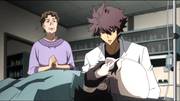
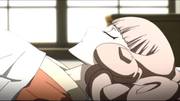
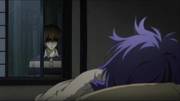
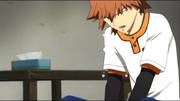

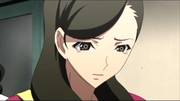



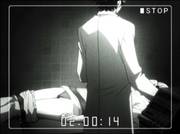
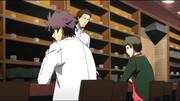

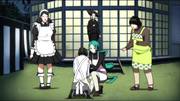
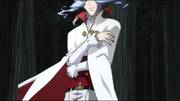

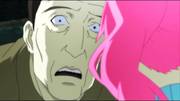


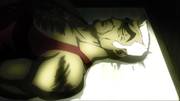
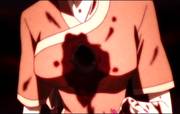
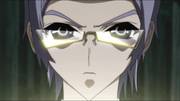

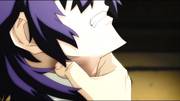
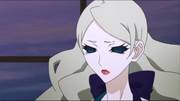
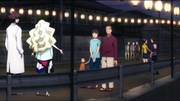






































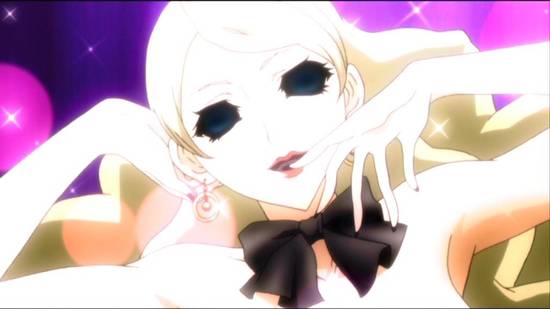








Your Opinions and Comments
Be the first to post a comment!